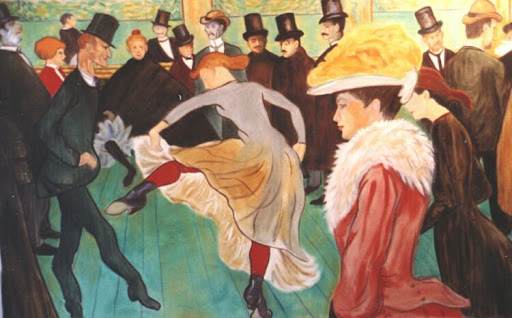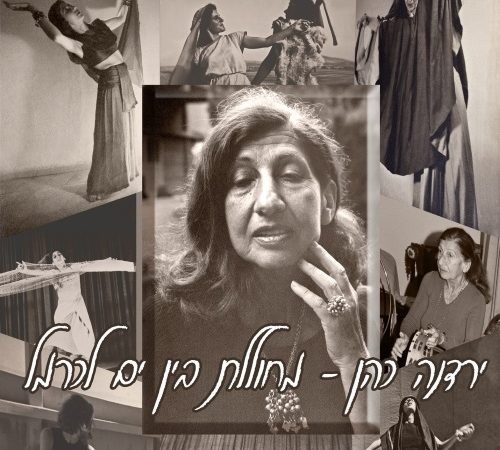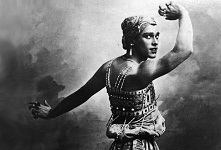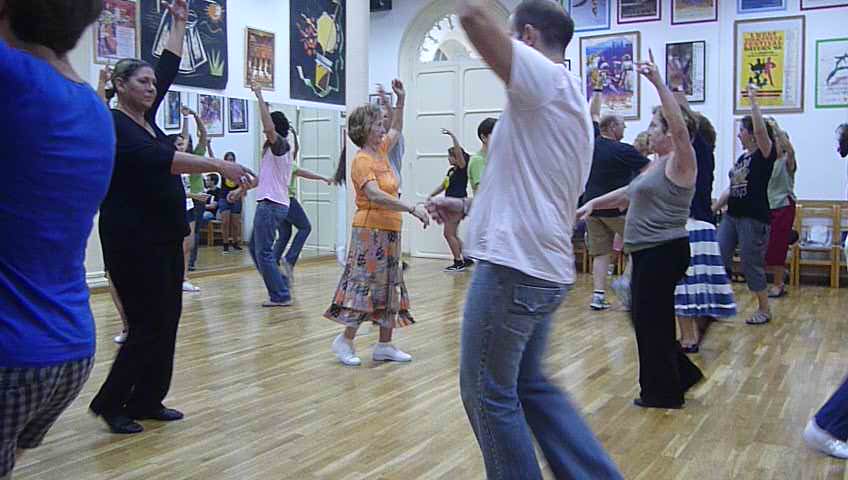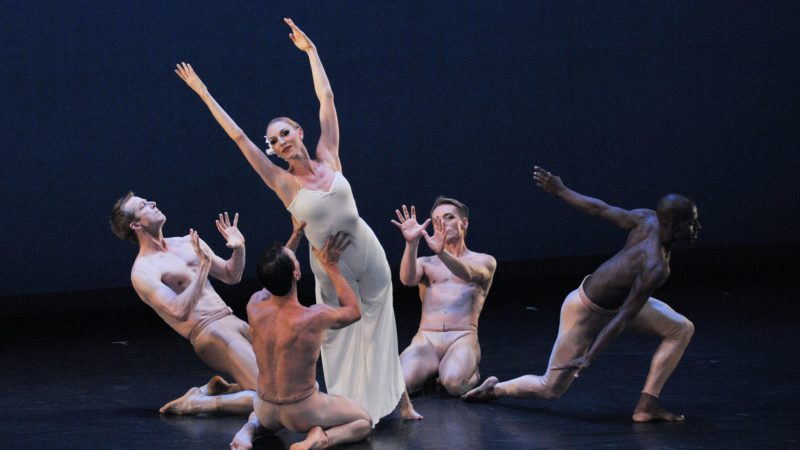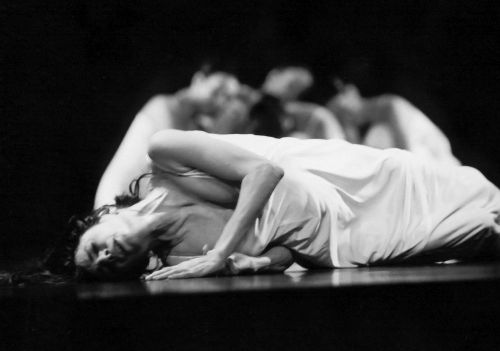The Great Revolt and the Return to the Roots – The Influence of Ausdruckstanz on Movement Theater in Israel
From the 1920s to the mid-50s, the main dance style in Israel was Ausdruckstanz. In the 50s, after approximately fifteen years of cultural isolation – World War II, Israel’s War of Independence and the economic depression of the 1950s in Israel – foreign dance companies from USA and Europe started performing in Israel.(1) The sharp technique, the technical polish, the sets and lighting were innovative at the time, and shocked the audience in Israel. Suddenly, people realized that Ausdruckstanz had practically passed from the map of global dance, and that the lights were shining upon American modern dance – especially that of Martha Graham.
From the early 1960s to the mid-70s, the influence of American modern dance was dominant in Israel, and it seemed that forty years of European Ausdruckstanz influence had been erased without a trace. However, in the second half of the 1970s, the innovative ideas of American Post-modern dance made their way to Israel, legitimizing ventures into non-establishment experimentation. Fringe dance came into being, and ‘Other Dance’ performances were created, re-awakening some elements of Ausdruckstanz. Imanuel Bar-Kadma wrote about the work of Ruth Ziv-Ayal, one of the central creators in this genre: “If you follow the historical trail of Israeli Modern dance, you will reach Gertrud Kraus [The most notable Ausdruckstanz dancer in Israel]… and perhaps also Martha Graham. If you will, Europe versus New York.”(2)
To what extent had Ausdruckstanz permeated, consciously or unconsciously, the works of Movement Theater creators in Israel? The question refers especially to the main creators in the Movement Theater style in the second half of the 1970s and in the early 80s, including Ruth Ziv-Ayal, Ruth Eshel, Rachel Kafri, Ronit Land, Rina Schenfeld, Oshra Elkayam, and Nava Zukerman. It is particularly relevant to the first works created in Israeli Fringe dance, in the late 70s and early 80s, when Movement Theater erupted in Israel, as aforementioned, influenced by American Post-modern dance.3 The question is not as relevant to the 1980s, when Pina Bausch’s works began influencing local creators, since Bausch’s own roots are in Ausdruckstanz.
Europe or USA?
In the second half of the 1970s, as some elements of Ausdruckstanz were unconsciously re-awakening in Israel, the question of Israeli dance’s artistic influences was being raised: who came first – Europe or the United States? The question is important because it implies a struggle between matter and form, between contents and formalism; European dance clearly favors matter over form, while American dance favors form – namely, pure movement – over matter.4
There is no Israeli literature referring to the pros and cons of American and European dance, or tackling the issue of a possible integration between the two – possibly because the Israeli dance community at the time was poor in research and interpretation of historic processes and changes in dance tendencies. However, the question whether Israeli art was turning to Europe or to the USA did preoccupy writers in other artistic fields. Gideon Ofrat, for instance, wrote: “Are we treading upon mounds of decaying past failures, in the European style? Are we taking an American technologic-pragmatic route? Are we creating out of the Eastern passivity of non-time? Are we creating out of Jewish cultural genetics, merging the dynamics of Kabbalistic destruction and redemption? […] We have not yet created a synthesis, but the contradictions between these four cultural options split every moment of our existence. Once more: past-future, passivity-activity, destruction-redemption – this is the fate of a Jewish immigrant society at a crossroads between East and West, between Europe and America, and between the great religions. Moreover, it is the artist’s fate here. He has no choice but to be associated with this complexity – neither America nor Europe, neither East nor Judaism. All of them concurrently.”5 Ofrat adds that art growing in American soil will encourage innovation and optimism, while German art will be entangled in its past, in legends, Medieval myths, the apocalypse and redemption attempts. My concern here is not to side with either, but to indicate the intensity of the gap between them. The birth of Movement Theater in Israel, legitimized by American Post-modern dance, and its continued development, influenced by German Ausdruckstanz and Dance Theater, bridged the two aesthetics.
The Roots
In the 1950s, most of the artists who created in the Movement Theater genre in the 70s were still young girls. They absorbed the special atmosphere that prevailed in Israel at the time, the first years of Israel’s independence, when Art felt compelled to make its contribution to the young State. Avishay Ayal stated: “There is something in the atmosphere of the late 50s in Israel that she [Ruth Ziv-Ayal] absorbed without being aware of it. Art has a message, a meaning, a narrative and contents. Art expresses national ideals and goals. […] Dance is a formal art, it is the art of the body and therefore it is an art form of Gentiles. Where did Jews dance? In weddings. All visual arts are essentially non-Jewish. The only legitimacy for creating Gentile art in our context is in some sort of ethical apologetics – namely, a message to the effect that this is profound, obviously complex, and not just entertainment; it is suffering – life, history, Jewish culture, our situation in Israel.”6
It should be mentioned that most of these creators were of Ashkenazi, European origins. The bookshelves in their homes featured Expressionist art books, the bedtime stories they were told were Grimm’s tales of witches and princesses in Medieval Europe, and on the radio they listened to concerts by Beethoven, Mozart, Haydn and Grieg. Despite the difficult economic times, their parents sent them to dance lessons, believing that children should get a cultural education. The girls danced and studied the piano, and the boys did gymnastics and studied the violin.
Most of Israel’s leading Movement Theater creators began their dance studies with teachers who taught in the Ausdruckstanz style. Classical ballet was unpopular at the time, since it was labeled ‘old-fashioned’ and ‘bourgeois’ art, and thus girls were sent to study the new dance form, which suited the spirit of the time.7 Ruth Ziv-Ayal studied with Naomi Aleskovsky, a soloist in Gertrud Kraus’s company, and performed in her dances. Rachel Kafri began her dance studies with Nahum Shahar, a student of Fred Berk and Katya Delakova.8 Oshra Elkayam was Gertrud Kraus’s student, and participated in her 1955 oratory Samson and Delilah. Mirali Sharon began her dance studies with Tille Rössler, a prominent teacher of the Ausdruckstanz style in Dresden who immigrated to Israel in the 1930s.9 Ronit Land was also Kraus’s student, and completed her studies in England in the New Dance style. According to Nava Zukerman, two performances in the 1950s particularly influenced her work. The first was Kraus’s solo in Habima’s theater production of Peer Gynt, and the second was Hana Meron’s performance in the play The Spirit Inn.10 This explains Zukerman’s choice to study dance at the Movement Department of the Kibbutz Seminar, headed by teachers identified with the Ausdruckstanz style.11 The only exceptions were Rina Schenfeld and myself, who had not studied with teachers identified with that style.
It is therefore no coincidence that when introduced to American Post-modern dance, these choreographers felt a kinship to its Metaphoric branch.12 They were influenced by the works of Meredith Monk and Kei Takei, and less taken with Analytical Post-modern dance, such as the works of Yvonne Rainer and Trisha Brown. Merce Cunningham and John Cage’s ideas were enthusiastically and appreciatively received in Israel, but no companies were established in Cunningham’s style.
Israeli creators adopted the use of everyday movements, the dismantling of traditional structures and, partially, the ‘chance’ method of creation as well as a joint creation process by choreographers and dancers and the use of props and electronic music, such as Cunningham’s work with Robert Rauschenberg and John Cage.
Postmodern dance re-awakened the dance recitals and small companies that had been typical of Ausdruckstanz dance in Israel. It also re-awakened the opposition to canonical style, and reinstated improvisation as a dominant element in a joint creation process by choreographer and dancers, along with the wish to create a personal movement idiom – as was the case in Ausdruckstanz.
Unlike Postmodern creators elsewhere, local ‘Other Dance’ creators had no wish to be liberated from message and expression. An analysis of works created by the first generation of Movement Theater creators in Israel indicates a common motif: a search for answers related to the nature of life and interpersonal relations – apparent especially in the works of Ruth Ziv-Ayal, Oshra Elkayam, and Nava Zukerman. Like Ausdruckstanz creators – whose most outstanding characteristic is the preoccupation with the self – they are in torment, wrestling and exposing themselves, their questions directed inwards. According to Gideon Ofrat, this implies delving into philosophy books, struggling and agonizing in weighty contemplation. Ofrat recognizes in such works the spirit of German Romanticism that gave birth to German Expressionism.13
Oshra Elkayam has been carrying for years notebooks filled with contemplations on the meaning of life. A reader might mistakenly assume that the writer is not a choreographer but a philosopher who insists on understanding whence she comes from and where she is headed, and how to pass the time between birth and death; how to reconcile the wish to conquer new goals, to climb ladders (Ladders, 1989), with a life spent dashing from one terminal to another (Terminal, 1984). The Death motif, typical of the Ausdruckstanz, has been haunting Elkayam since the death of her husband, a pilot in the Attrition War whose plane plummeted into the sea, never to be recovered. His sudden death and the lack of a gravesite reinforced her feelings of insecurity and remoteness.
Some of the works – Ziv-Ayal’s Remembered Headlines (1977) and Tear and Wear (1982), Zukerman’s Five Screams (1986), and Elkayam’s Ladders (1988) – reflect memories related to World War II in Europe. Reference to the Holocaust and to Fascism is only implied. The subject of Wear and Tear, for instance, is refugees, and “the characters created on stage are dressed in clothes that often remind us of Old Tel Aviv, of the mustiness emitted by the luxurious clothes of another world that was left behind, and of the scent of Eastern Europe that has wandered into the Middle East.”14
Elkayam’s Ladders is imbued with the magic of a contemporary fairytale; it is an odd story, in the spirit of the adventures of Baron of Munchhausen, about a man who ‘fishes’ his wife. The apartment in which the pair lives seems ordinary enough, but a second look reveals that it is ‘enchanted’. The table and chairs have legs in different heights, and the table is also oddly tilted. Cinematic characters enter and exit the apartment through the window, like an American version of the knights and princes of European legends.
A Gown of Stones (1980) by the author, in collaboration with the sculptor Abraham Offek, revolves around a purification ritual, and Diapered Branches (1983) and Myth (1986), in collaboration with the sculptress Dalia Meiri, deals with fertility and birth. Thus, the works respond to an internal, unconscious need for purification and immortality, a wish to endow life and action with meaning beyond daily routine. This is comparable to Mary Wigman’s works, dealing with a demonic world of super-human ecstasy and obsessions.15
It is abundantly clear that Israeli creators have never waived expression and message. Following Pina Bausch’s visit to Israel, her style became a role model and Israeli creators of Movement Theater were confirmed in what they had already been doing unconsciously. However, Movement Theater productions in Israel are much poorer, with fewer participants, they are less violent and their movement is richer
The Ausdruckstanz style of these creators’ early studies was suddenly seen in a new light. However, their work does not exhibit the expression and feeling of Ausdruckstanz as they had first studied it, nor does it demonstrate the expression and dramatic feeling of Modern American dance, to which they were exposed later; it is a combination of the two, supplemented by distance and ‘objectivity’ inspired by Metaphoric Post-modern dance.
In their eagerness to adopt Modern American dance in the early 1960s, and to create ‘Other Dance’, inspired by the great revolt of Post-modern dance, in the late 70s, creators failed to notice how connected they have remained to the Ausdruckstanz style. In retrospect, thirty years later, they have realized what they hadn’t known at the time – Ausdruckstanz had permeated them.
Notes
This article was originally published in Dance Today – the dance magazine of Israel, issue no.10, January 2003.
1. Among the companies that arrived during the early 1950s: Ballet Tropicana (1952), Ballets des Camps Elysées, Roland Petit, London Festival Ballet, Pearl Primus (1951).
2. Imanuel Bar-Kadma, “The Man’s Visit,” Yedioth Ahronoth, 25 July 1986. Gertrud Kraus was the most prominent dancer and choreographer in the Ausdruckstanz style in Israel.
3. On the relation between American Postmodern dance and the inception of Fringe dance in Israel, see: Ruth Eshel, “Institutionalization and Centralization: Dance in Israel 1964-1977,” Dancetoday, no. 6., Sept. 2001, pp.4-14. [Hebrew and English].
4. Manning and Benson, “An American Perspective on Tanztheater,” The Drama Review, no. 20, Vol. 2, Summer 1986, pp. 57-59.
5. Gideon Ofrat, “What do Israeli Painters Feed on?” Ha’aretz, 14 Feb. 1986 [Hebrew]; Also printed in: Touching – Israeli Art in the Late 1980s (Jerusalem: Israeli Art, 1988, p. 60. [Hebrew]
6. Ruth Eshel, interview with Avishay Ayal, December 1995.
7. See: Ruth Eshel. “Classical Ballet – Israel Dance`s Stepson,” Dancetody, no. 2, July 2000, pp. 85-93. [Hebrew and English]. Also: Ruth Eshel, Dancing with the Dream – The Development of Artistic Dance in Israel 1920-1964 (Tel Aviv: Poalim Library, 1991), pp. 49-62. [Hebrew]
8. Berk danced in Kraus company in Vienna. On the work of Fred Berk and his wife, Katya Delakova, see: Judith Brin Ingber, Victory Dances – The Life of Fred Berk (Tel Aviv: The Dance Library of Israel, 1985). [Hebrew]
9. See Tille Rössler’s file at the Dance Library of Israel, Tel Aviv.
10. Ruth Eshel, interview with Nava Zukerman, August 1996.
11.The Institute for Movement Education was founded by Yehudit Bineter and Lotte Kirstele. Dance studies at the Kibbutz Seminar (as in the Kibbutz in general) were influenced by the Ausdruckstanz style, and did not reflect general tendencies in Israel.
12. In retrospect, after Sally Banes’ book Terpsichore in Sneakers: Post-Modern Dance was published, it became apparent that Israeli creators were closer to that sub-current of Post-modern dance than to Analytical Post-modern dance. The Metaphoric Postmodern dance did not disparage feelings, mixing art forms, narrative and theatricality.
13. Gideon Ofrat, Touching – Israeli Art, p. 118.
14. Shosh Weitz, “Relations Constructed and de-Constructed,” Yedioth Ahronoth, 23 March 1984. [Hebrew]
15. The demon and ecstasy are mentioned in the title of Susan Manning’s book on Mary Wigman’s work: Ecstasy and the Demon: Feminism and Nationalism in the Dances of Mary Wigman (Berkeley: University of California Press, 1993).
